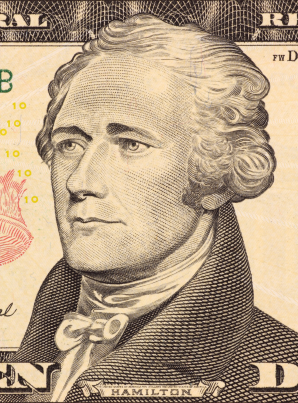George Washington Supports Hamilton’s Bank Derivative Plan
The first cabinet was formed sometime after Washington was inaugurated on April 30, 1789. His choice for Secretary of the Treasury was Alexander Hamilton, his most trusted and valuable aide during the Revolution where Washington learned to appreciate the ideas from Hamilton’s very fertile mind.
 Hamilton’s first order of business was to establish the credit of the new Country. In doing so he needed to set up the mechanism to borrow, create currency and launch an orderly conduct of business. His idea was to create a central bank – the First Bank of the United States (”BUS”) which was chartered for twenty years by Congress on February 25, 1791. Washington gave this idea his full support.
Hamilton’s first order of business was to establish the credit of the new Country. In doing so he needed to set up the mechanism to borrow, create currency and launch an orderly conduct of business. His idea was to create a central bank – the First Bank of the United States (”BUS”) which was chartered for twenty years by Congress on February 25, 1791. Washington gave this idea his full support.
Hamilton’s plan was to use derivatives. You may have heard of derivatives. They are the big bad things that brought down Lehman Brothers, Bear Stearns, Merrill Lynch, AIG and many other illustrious financial organizations. Actually, in my opinion, it wasn’t the derivatives that brought them down, it was how they were used with irresponsible leverage and extreme greed. However, shoot the messenger, let’s blame the derivatives…
By the way, on some level, cash is a derivative. In the Bible the Israelites were commanded to bring sacrifices to the Temple. Those that did not live within a day’s ride of the Temple were permitted to convert the animals they were going to offer to the priests into money before they started their journey. When they arrived, they could reconvert the money into animals. Money being used in this way makes money a derivative. Money isn’t the real thing – it is a substitute for the real thing! That is what a derivative is – something that derives its value from something else. So, cash is a derivative!
Back to Washington and Hamilton. Hamilton’s BUS needed $10 million funding. The government would purchase the first $2 million in shares with money it would borrow from the BUS [to be used to buy the shares from the BUS] to be paid back in 10 annual installments. The remaining $8 million would be purchased by the public. One quarter of the price of the shares had to be paid in gold or silver (referred to them as “real money”) and the balance in federal debt bonds (described in next paragraph). Therefore, the BUS would initially have $500,000 in gold or silver that it received from the government’s purchase that it could use as security to make other loans which would be used by the public to buy its shares providing the additional capital to the BUS.
The 75% of the share price received by the BUS had to be in the 6% federal debt bonds issued under the Funding Act of 1790. Because the 1790 bonds were the only things that could be used for payment besides gold and silver, the value of those bonds was run up by investors that wanted to acquire shares in the BUS.
So, the federal government issued bonds that were used to buy shares in a new bank established by the federal government with the BUS ending up with the bonds that were to be repaid with the money the federal government originally received for those bonds.
Confusing? Most derivatives are confusing… usually obscuring the true intent of what is happening. However, Hamilton’s plan worked and today we have a solvent credible credit-worthy nation. Possibly!
How Can We Help?



